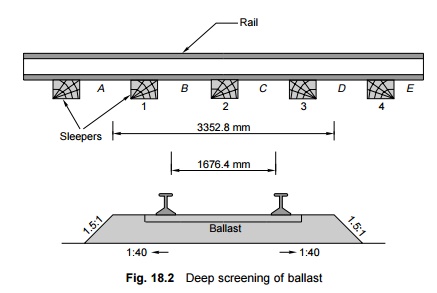Chapter: Civil : Railway Airport Harbour Engineering : Railway Engineering : Track Maintenance
Deep Screening of Ballast

Deep Screening of Ballast
Deep screening of the ballast is
done to ensure that a clean ballast cushion of the required depth is available
below the lower half of the sleepers, which is necessary for providing the
proper drainage and elasticity to the track. In the absence of a clean ballast
cushion of the desired depth, track geometry may get disturbed, affecting the
performance of the track.
Deep screening is normally
carried out under speed restrictions without obtaining a traffic block. It is
desirable to proceed with deep screening in a direction opposite to that of the
traffic. An adequate quantity of ballast, the necessary equipment and tools,
and the required labour should all be arranged well in time. Work should not be
carried out during monsoons. The procedure for deep screening is as follows.
(a) A group
of four sleepers are tackled one at a time in sequence. As shown in Fig. 18.2,
each of the sleepers (numbered 1, 2, 3, and 4, etc.) is tackled individually.
(b) The
ballast from spaces A and B is removed right down to the formation and wooden
blocks are put in its place to support the track. Precautions are taken to
avoid digging out the consolidated top of the formation.
(c) The
ballast is removed from under sleeper 1, screened, placed under the same
sleeper, packed.
(d) The
wooden block is removed from space A.
(e) The
ballast from space C is removed and placed after screening in space A. If
additional ballast is required, it may be taken from the extra ballast trained
out in advance along the side of the track.
(f) The
wooden block that was removed from space A is placed in space C. Sleeper 2 is
provided with wooden blocks on either side in order to support the track.
(g) The
ballast under sleeper 2 is removed, a screened ballast is provided in its
place, and the sleeper is packed.
(h) Ballast
from space D is removed, screened, and placed in space B. Any extra ballast
that my be needed is taken from the track.
(i) The
wooden block from space B is removed and put in space D to support the rail.
(j) The
procedure is repeated till the work is completed.
It can be seen from this procedure
that work is done in such a way that when the ballast is being excavated from
under one sleeper, there are at least four sleepers between this sleeper and
the next sleeper that is being worked upon. The track is also lifted, if
required. This should only be done at a rate of 50 mm (2") at a time. It
should be ensured that the packing, cross level, and grading-off are
satisfactory before closing the day's work.
Deep screening is done under a
speed restriction of 15 km/h. This speed can be released to normal speeds in
the following ways.
Manual packing By manual
packing four times in succession and by picking up slacks over a
period of 21 days.
Machine packing Packing
with the help of tie machines, by tamping the track thrice
followed by picking up slacks over a period of 10 days.
Related Topics